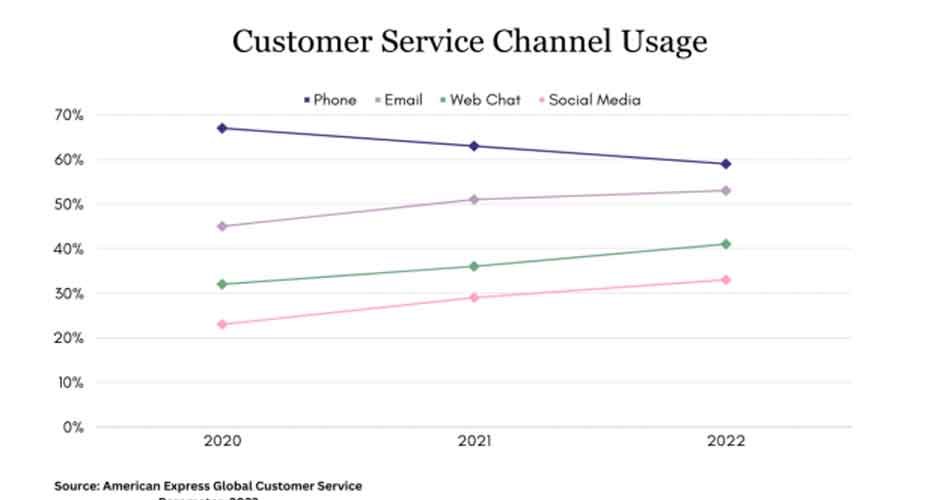
The contact center landscape is continuously changing due to rapid technological advancements. Disruptions such as the COVID-19 pandemic have also influenced these changes. These changes have led to a shift towards remote operations. This shift also reflects the increasing demand for innovative solutions. Currently, the focus is on innovations that can transform customer experiences.
Meeting the Challenges of Modern Contact Centers
Contact centers today face various pressing challenges. These challenges range from managing omnichannel customer journeys to maintaining operational efficiency. The following list outlines these challenges with accompanying descriptions.
Uncertainty About the Customer Journey
Many businesses operate using a siloed model. This lacks insight into the customer journey. However, understanding the customer journey is crucial for success in modern contact centers. Consequently, organizations should transition their contact centers to a unified omnichannel model.
Higher Resolution Cycle
Some customer issues need many touchpoints to get resolved. This often occurs due to communication issues or the lack of live assistance. Consequently, extended queue times can lead to customer frustration.
Impact Customer Service Costs
The customer service costs include human resources and infrastructure costs. These costs are essential for managing the call center process. When resolving customer issues requires more interactions, it increases these costs.
Adopting a contact center solution helps companies overcome those challenges. They can improve their support KPI. A Deloitte study found that over 75% of contact center leaders cite the following as top priorities:
- Improving omnichannel capabilities
- Visual engagement tools
- Integrating artificial intelligence
The need for robust solutions to address these pain points is irrefutable.
Achieving Seamless Omnichannel Communication

Customers typically use an average of nine touchpoints to interact with brands. Delivering consistent experiences across these touchpoints is vital. A Salesforce report found that 60% of customer inquiries occur through online channels.
Omnichannel platforms facilitate seamless conversations across various channels. The popular channels used are voice, SMS, social media, messaging apps, and more.
A study by Dimension Data found that 66% of customers used more self-service options compared to speaking with call center agents in 2020.
89% of companies with advanced omnichannel capabilities saw an increase in customer satisfaction. This data was researched by Omnisend.
Benefits of omnichannel customer engagement:
- 91% higher YoY growth for businesses leveraging omnichannel versus limited integration.
- Enhanced context from customer journey data across touchpoints.
- Higher customer retention through flexible channel switching.
- Lower operational costs by deflecting to digital self-service channels.
But, achieving true omnichannel effectiveness involves challenges:
- Data fragmentation across channels makes understanding journeys difficult.
- Inconsistent experiences happen if workflows and content aren’t integrated.
- Old legacy systems can inhibit flexibility to scale emerging channels.
To overcome these barriers, businesses need robust solutions for:
- Journey orchestration across channels.
- Centralized data and analytics.
- Scalable contact center infrastructure.
Revolutionizing Service with Visual Engagement Tools
TechSee reports that visuals represent 90% of the information transmitted to the human brain. Therefore, visual engagement is pivotal in customer service. Visual support tools like co-browsing, live video, and augmented reality optimize issue resolution.
- Co-browsing allows agents to engage visually and guide customers in real-time.
- Live video chat enables visual identification and troubleshooting.
- Augmented reality facilitates remote assistance through digital annotations.
Brands that integrate visual engagement tools have reported 20% higher customer satisfaction. Along with that is a 38% faster issue resolution. As visual-first creatures, facilitating visual support empowers agents and generates positive outcomes.
Harnessing AI for Predictive Customer Service
Innovations in Artificial Intelligence are revolutionizing contact centers. Gartner predicts more than 25% efficiency gains by 2025 due to AI-enabled customer engagement platforms. The power of AI goes beyond automating mundane tasks. When properly integrated, AI enhances customer satisfaction through personalization and predictive support.
Key AI Capabilities:
- Sentiment Analysis
Using NLP and machine learning algorithms. It also uses sentiment analysis to classify text, voice, or visual cues based on the underlying mood. The moods can be positive, negative, or neutral. Key applications:
- Determining disgruntled customers to focus on support.
- Identifying frustrated callers for faster transfer to human agents.
- Personalizing responses based on customer emotions.
- Predictive Analytics
By discovering correlations in customer data, businesses can expect needs even before they arise. Use cases:
- Predict the likelihood of purchase fallout and proactively retain customers.
- Lower customer churn by addressing pain points early on.
- Make real-time promotion recommendations derived from purchase trends.
- Intelligent Chatbots
Advanced chatbots, equipped with NLP, do more than swiftly resolve repetitive inquiries; they also:
- Understand customer questions
- Request clarification
- Handle complex conversations
As per a SurveyMonkey poll, 10% of customers emphasize the efficiency and high response rate of chatbots compared to human agents. AI has immensely benefited industries from healthcare to e-commerce.
But human empathy remains vital where highly emotional nuances are involved. The goal is to find the right balance between cutting-edge technology and meaningful human connections. That’s where the future of AI-powered customer service shines brightest.
The Future of Contact Centers
The innovations above showcase how intelligent solutions deliver simple, swift experiences. Modern contact centers need to integrate these leading-edge technologies. This approach will equip them to serve customers seamlessly across channels. At the same time, they will be maximizing efficiency.
The future promises elevated customer satisfaction. Alongside it is improved call center revenues and performance. This achievement is made possible through solutions that:
- Simplify customer journeys
- Enhance visual engagement
- Apply predictive insights
- Optimize automated messaging
Frequently Asked Questions
What are the benefits of omnichannel customer engagement?
Omnichannel communication unifies customer journeys across various touchpoints. This leads to increased satisfaction through quick, context-aware experiences. It also provides flexibility for customers to switch channels conveniently.
Can visual engagement tools effectively replace in-person customer service?
Replicating face-to-face interactions is challenging. Visual engagement tools come remarkably close by enabling real-time visual support. Features like co-browsing and augmented reality meaningfully convey facial expressions, gestures, and more. These all optimize communications.
What Role Does AI Play in Modernizing Customer Service Operations?
AI drives evolution through automation for:
- Repetitive tasks
- Predictive insights from sentiment analysis
- Natural language processing for chatbots
Such capabilities reduce costs, enable personalization, and enhance customer satisfaction. While AI has limitations in complex emotional interactions, it excels at streamlined service.

